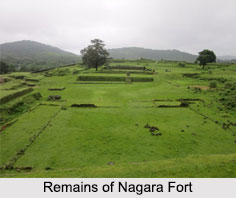 Nagara Fort is located in Nagara village of Shimoga District of Karnataka. This fort, also called Shivappa Naik"s fort, is maintained by the Archaeological Survey of India. The fort was built in 16th century and was the last capital city of the Keladi rulers. In 1763, Hyder Ali, Sarvadhikari of Mysore captured the fort and named it "Hydernagar" or "Hydernagara" after his name Hyder. The fort is built on a small hill, beside a lake with the system of circulating water around it for safety. Within the fort, there are Darbar Hall, remains of palace, two tanks named Akka Thangi Kola and cannon. Apart from the nagara Fort, Devaganga tank, Neelakenteshwara Temple and Gudde Venkataramana Swamy Temple are also worth visiting, which are located near the fort.
Nagara Fort is located in Nagara village of Shimoga District of Karnataka. This fort, also called Shivappa Naik"s fort, is maintained by the Archaeological Survey of India. The fort was built in 16th century and was the last capital city of the Keladi rulers. In 1763, Hyder Ali, Sarvadhikari of Mysore captured the fort and named it "Hydernagar" or "Hydernagara" after his name Hyder. The fort is built on a small hill, beside a lake with the system of circulating water around it for safety. Within the fort, there are Darbar Hall, remains of palace, two tanks named Akka Thangi Kola and cannon. Apart from the nagara Fort, Devaganga tank, Neelakenteshwara Temple and Gudde Venkataramana Swamy Temple are also worth visiting, which are located near the fort.
Visiting Information to Nagara Fort
The best time to visit the fort is from September to February. Hosanagara is the nearest town to Nagara village (17 km). Shivamogga Town Railway Station (82 km) Mangalore Airport (147 km) are the nearest to reach this fort. National Highway 13 connects the Shimoga District to other places of Karnataka.
This article is a stub. You can enrich by adding more information to it. Send your Write Up to content@indianetzone.com



















